- Home
- About Us
- Industry
- Services
- Reading
- Contact Us
Gear Motors Market: Current Analysis and Forecast (2024-2032)
Emphasis on Gear Type (Helical, Planetary, Helical-Bevel Gear, Worm, and Others); End-Users (Food & Beverage, Automotive, Metal & Mining, Material Handling, Oil & Gas, and Others); Rated Power (7.5 Kw, 7.5 Kw-75kW, and above 75kW); and Region/Country
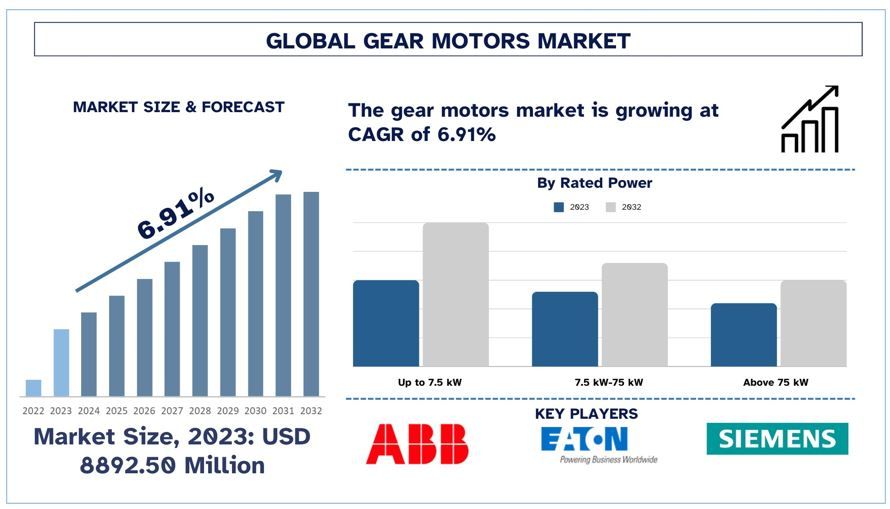 Gear Motors Market Size & Forecast
Gear Motors Market Size & Forecast
The Gear Motors market was valued at approximately USD 8892.50 Million in 2023 and is expected to grow at a robust CAGR of around 6.91% during the forecast period (2024-2032) owing to the increasing automation in industries, the demand for energy-efficient solutions, and the adoption of smart technologies like IoT for enhanced operational efficiency.
Gear Motors Market Analysis
The global gear motors market is on the rise and has decent growth momentum due to the rising trends in automation across the industrial sectors and the rising focus on energy conservation. Automotive and food and beverage, material handling, and packaging are some of the industries that play a significant role in consuming gear motors in various uses as conveyor gear motors and robotic assembly gear motors. Furthermore, the demand for renewable energy sources is rising globally, which in turn is expanding the usage of gear motors in wind turbines and solar tracking systems. Other drivers that have buoyed the market include the sustaining industrialization process in emerging nations and the advancement of production plants in developed areas.
Market key players are adopting strategies like partnership, and investment to gain more growth in the market. In 2024, Rockwell Automation announced the opening of a new facility in Chennai, India, to enhance its regional operations and support its growing customer base in the area. This new facility will focus on advanced manufacturing, engineering, and technology services, aimed at driving innovation and providing localized solutions for automation and digital transformation. The investment in Chennai underscores Rockwell Automation’s commitment to expanding its footprint in India and strengthening its presence in the rapidly growing industrial automation market. To achieve further growth in the global gear motors market, players should emphasize smart technologies such as IoT and AI. These technologies, when integrated into gear motor solutions, allow companies to provide products with improved performance, monitoring, and previously impossible predictive maintenance. Besides enhancing the helpful and dependable aspects of gear motors, this also draws industries that require new solutions at reduced prices. Further, an increase in internationalization and globalization of partnerships and affiliations can enhance an organization’s reach to new markets and customers for global business advancement.
Gear Motors Market Trends
This section discusses the key market trends influencing the gear motors market segments as identified by our research experts.
Gear Type Transforming Industry
The helical segment has significantly contributed to the market’s growth by capturing a substantial share within its gear-type segment. Helical gears are widely used in a gear motor due to their operational characteristics that are continually improving, this is one of the driving forces in the industry. As compared to spur gears, helical gears have teeth that are inclined, and this means that the two gears engage smoothly and gradually. This design, in turn, provides the capability of minimizing noise and vibrations during operation, which is a noteworthy factor for applications that call for accurate work and low noise in any way possible, for example, in medical applications, robotics, and automation. Two main factors have imposed the use of helical gears in gear motors: increasing precision in the manufacturing of machines and the rising need for quiet working in industrial sections. Thus, manufacturers are paying more heed to procuring better and superior Helical gear motors to deal with the intensifying demands of these complex applications.
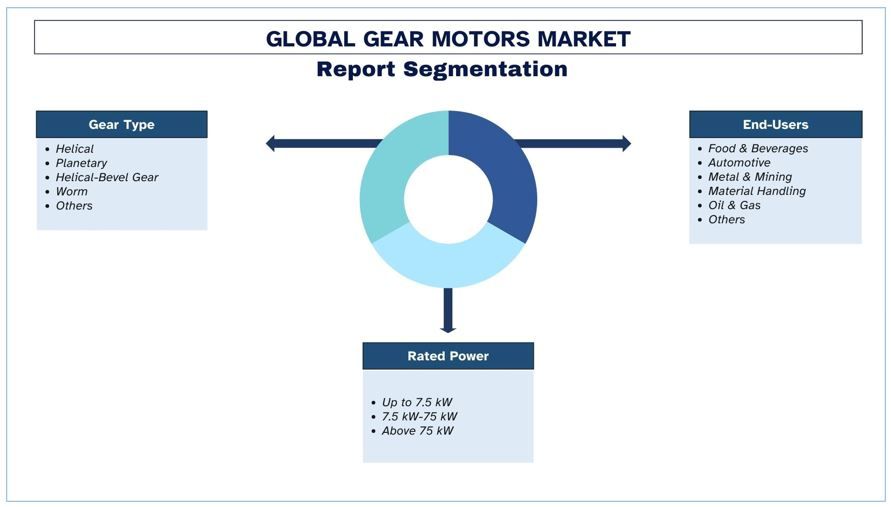
Asia Pacific is Expected to Grow with Significant CAGR During Forecast Period
The Asia Pacific gear motors market is in a growth phase due to industrialization across the region and more focus on automation systems. Market leaders are China, India, and Japan due to their high manufacturing industries and increased concern towards increased productivity. Cars, electronics, and machinery are some of the industries that use gear motors in this part of the world. Besides this, the escalating need for energy-efficient solutions is promoting the use of sophisticated gear motor systems. The use of IoT and AI in predictive maintenance and operations is still advancing the market even higher. For instance, Chinese automotive manufacturer BYD has officially opened its first electric vehicle (EV) manufacturing plant in Southeast Asia, located in Rayong, Thailand. The factory, inaugurated on July 4, 2024, represents a significant investment of approximately USD 490 million and is part of BYD’s strategy to expand its presence in the rapidly growing EV market in the region.
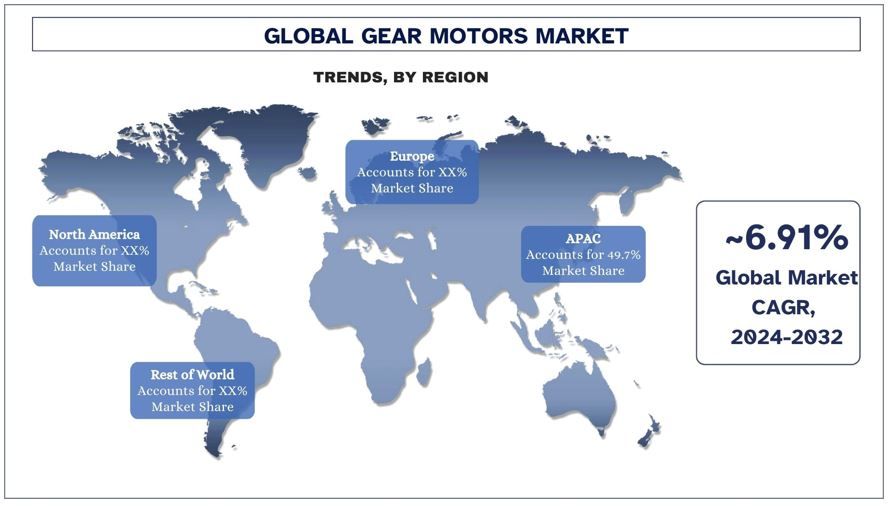
Gear Motors Industry Overview
The gear motors market is competitive, with several global and international market players. The key players are adopting different growth strategies to enhance their market presence, such as partnerships, agreements, collaborations, new product launches, geographical expansions, and mergers and acquisitions. Some of the major players operating in the market are Eaton, Siemens, ABB, SEW-EURODRIVE, Flender, WEG Gear Systems GmbH, Altra Industrial Motion Corp, Sumitomo Heavy Industries, Ltd, Emerson Electric Co., and Elecon Engineering Company Limited.
Gear Motors Market News
- For instance, GE Aerospace announced a strategic investment of more than EUR64 million (approximately USD 70 million) in its European manufacturing facilities. This initiative, which will be implemented throughout 2024, aims to enhance production capabilities for both commercial and military jet engines, focusing on the development of next-generation technologies for improved efficiency and performance.
- Nissan has pledged another USD 2.5 billion to its British factory with the confirmation of two fully electric SUVs. The plant is consistently one of Europe’s most productive, with one car rolling off its production lines every two minutes. It produced 325,458 vehicles in the 23/24 fiscal year.
Gear Motors Market Report Coverage
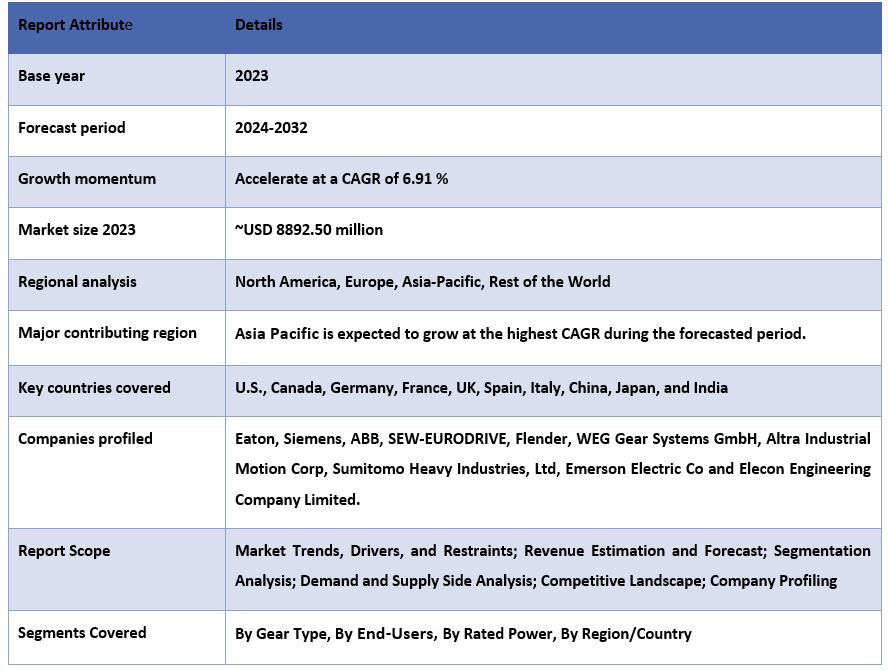
Reasons to buy this report:
- The study includes market sizing and forecasting analysis validated by authenticated key industry experts.
- The report presents a quick review of overall industry performance at one glance.
- The report covers an in-depth analysis of prominent industry peers with a primary focus on key business financials, product portfolios, expansion strategies, and recent developments.
- Detailed examination of drivers, restraints, key trends, and opportunities prevailing in the industry.
- The study comprehensively covers the market across different segments.
- Deep dive regional level analysis of the industry.
Customization Options:
The global gear motors market can further be customized as per the requirement or any other market segment. Besides this, UMI understands that you may have your own business needs; hence, feel free to connect with us to get a report that completely suits your requirements.
Table of Content
Research Methodology for the Gear Motors Market Analysis (2022-2032)
Analyzing the historical market, estimating the current market, and forecasting the future market of the global Gear Motors market were the three major steps undertaken to create and analyze the adoption of Gear Motors in major regions globally. Exhaustive secondary research was conducted to collect the historical market numbers and estimate the current market size. Secondly, numerous findings and assumptions were taken into consideration to validate these insights. Moreover, exhaustive primary interviews were also conducted, with industry experts across the value chain of the global Gear Motors market. Post assumption and validation of market numbers through primary interviews, we employed a top-down/bottom-up approach to forecasting the complete market size. Thereafter, market breakdown and data triangulation methods were adopted to estimate and analyze the market size of segments and sub-segments of the industry. Detailed methodology is explained below:
Analysis of Historical Market Size
Step 1: In-Depth Study of Secondary Sources:
A detailed secondary study was conducted to obtain the historical market size of the Gear Motors market through company internal sources such as annual reports & financial statements, performance presentations, press releases, etc., and external sources including journals, news & articles, government publications, competitor publications, sector reports, third-party database, and other credible publications.
Step 2: Market Segmentation:
After obtaining the historical market size of the gear motors market, we conducted a detailed secondary analysis to gather historical market insights and share for different segments & sub-segments for major regions. Major segments are included in the report, such as gear type, end-users, rated power, and regions. Further country-level analyses were conducted to evaluate the overall adoption of testing models in that region.
Step 3: Factor Analysis:
After acquiring the historical market size of different segments and sub-segments, we conducted a detailed factor analysis to estimate the current market size of the Gear Motors market. Further, we conducted factor analysis using dependent and independent variables such as gear type, end-users, rated power, and gear motors market regions. A thorough analysis was conducted of demand and supply-side scenarios considering top partnerships, mergers and acquisitions, business expansion, and product launches in the Gear Motors market sector across the globe.
Current Market Size Estimate & Forecast
Current Market Sizing: Based on actionable insights from the above three steps, we arrived at the current market size, key players in the global Gear Motors market, and market shares of the segments. All the required percentage shares split, and market breakdowns were determined using the above-mentioned secondary approach and were verified through primary interviews.
Estimation & Forecasting: For market estimation and forecast, weights were assigned to different factors including drivers & trends, restraints, and opportunities available for the stakeholders. After analyzing these factors, relevant forecasting techniques i.e., the top-down/bottom-up approach were applied to arrive at the market forecast for 2032 for different segments and sub-segments across the major markets globally. The research methodology adopted to estimate the market size encompasses:
- The industry’s market size, in terms of revenue (USD) and the adoption rate of the gear motors market across the major markets domestically
- All percentage shares, splits, and breakdowns of market segments and sub-segments
- Key players in the global gear motors market in terms of products offered. Also, the growth strategies adopted by these players to compete in the fast-growing market
Market Size and Share Validation
Primary Research: In-depth interviews were conducted with the Key Opinion Leaders (KOLs), including Top Level Executives (CXO/VPs, Sales Head, Marketing Head, Operational Head, Regional Head, Country Head, etc.) across major regions. Primary research findings were then summarized, and statistical analysis was performed to prove the stated hypothesis. Inputs from primary research were consolidated with secondary findings, hence turning information into actionable insights.
Split of Primary Participants in Different Regions
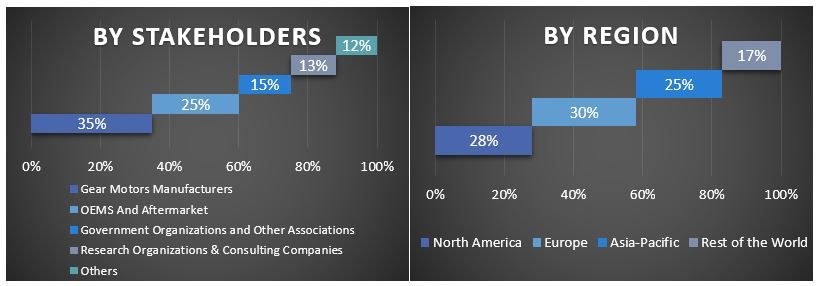
Market Engineering
The data triangulation technique was employed to complete the overall market estimation and to arrive at precise statistical numbers for each segment and sub-segment of the global gear motors market. Data was split into several segments and sub-segments after studying various parameters and trends in the gear type, end-users, rated power, and regions of the global Gear Motors market.
The main objective of the Global Gear Motors Market Study
The current & future market trends of the global gear motors market were pinpointed in the study. Investors can gain strategic insights to base their discretion for investments on the qualitative and quantitative analysis performed in the study. Current and future market trends determined the overall attractiveness of the market at a regional level, providing a platform for the industrial participant to exploit the untapped market to benefit from a first-mover advantage. Other quantitative goals of the studies include:
- Analyze the current and forecast market size of the Gear Motors market in terms of value (USD). Also, analyze the current and forecast market size of different segments and sub-segments.
- Segments in the study include areas of gear type, end-users, rated power, and regions.
- Define and analyze the regulatory framework for the Gear Motors
- Analyze the value chain involved with the presence of various intermediaries, along with analyzing customer and competitor behaviors of the industry.
- Analyze the current and forecast market size of the Gear Motors market for the major region.
- Major countries of regions studied in the report include Asia Pacific, Europe, North America, and the Rest of the World
- Company profiles of the Gear Motors market and the growth strategies adopted by the market players to sustain in the fast-growing market.
- Deep dive regional level analysis of the industry
Frequently Asked Questions FAQs
Q1: What is the global gear motors market's current size and growth potential?
Q2: What are the driving factors for the growth of the global gear motors market?
Q3: Which segment has the largest share of the global gear motors market by gear type?
Q4: What are the emerging technologies and trends in the global gear motors market?
Q5: Which region will dominate the global gear motors market?
Related Reports
Customers who bought this item also bought










